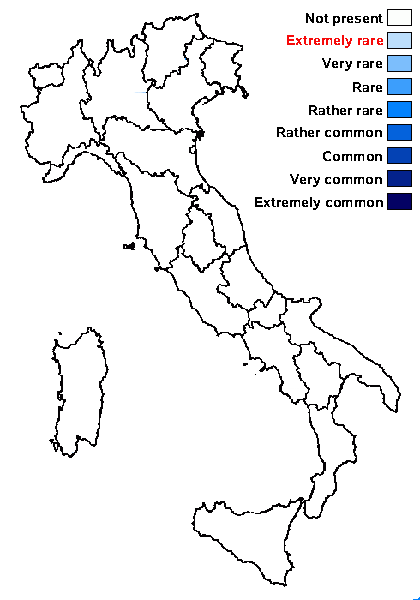Verrucaria lacerata Servít
Stud. Bot. Čech. ,11, 3: 115, 1950
Synonyms:
Distribution:
Description: Thallus crustose, whitish grey, endosubstratic or thinly hemiendosubstratic and then finely rimose especially around the perithecia. Perithecia black, up to half-immersed in flat pits in the rock, hemispherically projecting with the upper half. Involucrellum apical or reaching up to mid-level, rather thick, lacerate and poorly delimited in lower part, impregnated with substrate granules and crystals, fading in lower part; exciple globose, 0.4-0.6 mm across, the wall 40-50 μm thick, black throughout; hamathecium of branched and anastomosing, 40-70 μm long periphyses and periphysoids, interascal filaments absent; hymenial gel hemiamyloid, I+ red (I+ blue at very low concentrations of I), K/I+ blue. Asci 8-spored, clavate, I-, fissitunicate, the wall thickened above, with an ocular chamber, dehiscent by extrusion of an endotunica to form a delicate rostrum, Verrucaria-type. Ascospores 1-celled, hyaline, ellipsoid, 30-37(-40) x 15-18 μm. Photobiont chlorococcoid. Spot tests: K-, C-, KC-, P-, UV-. Chemistry: without lichen substances.
Note: a calcicolous species described from the Tatra Mnts. and reported from scattered localities in Central Europe, including the Eastern Alps (Austria and Slovenia, near the Italian border). To be looked for in Italy.
Growth form: Crustose
Substrata: rocks
Photobiont: green algae other than Trentepohlia
Reproductive strategy: mainly sexual
Poorly known taxon in need of further study

Predictive model
Growth form: Crustose
Substrata: rocks
Photobiont: green algae other than Trentepohlia
Reproductive strategy: mainly sexual
Poorly known taxon in need of further study

Predictive model
 INDEX FUNGORUM
INDEX FUNGORUM
 GBIF
GBIF

